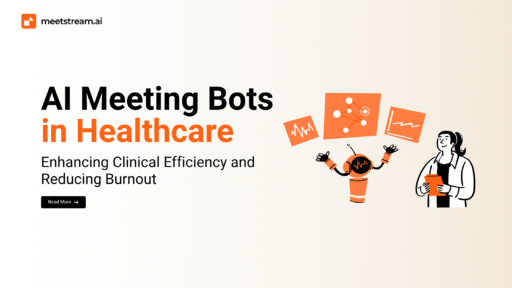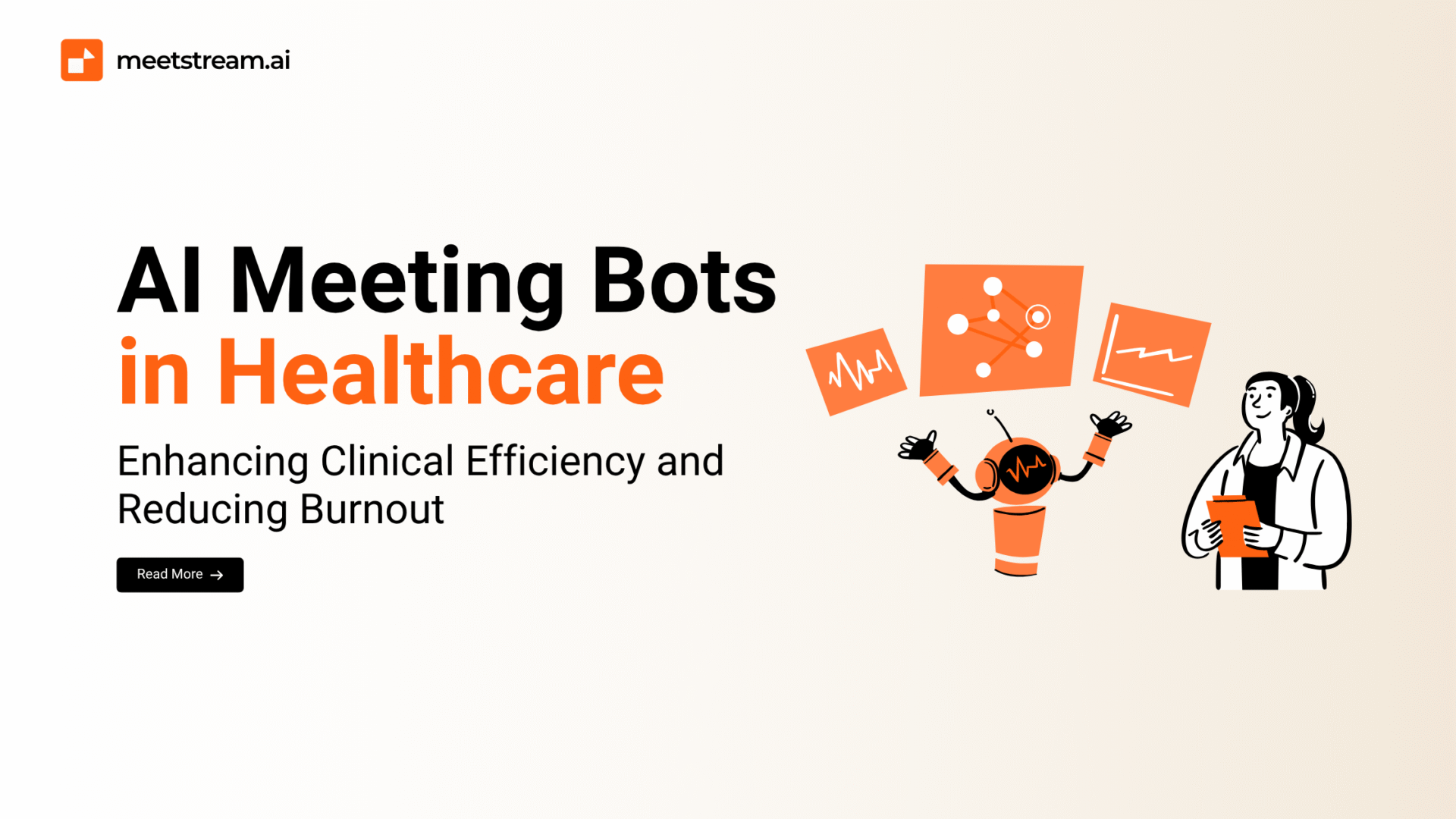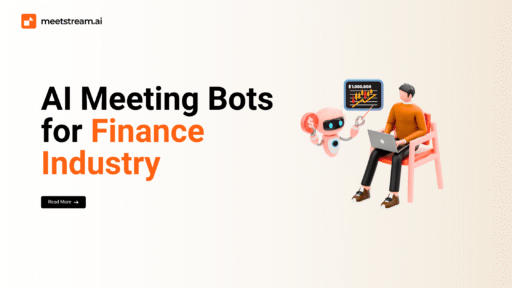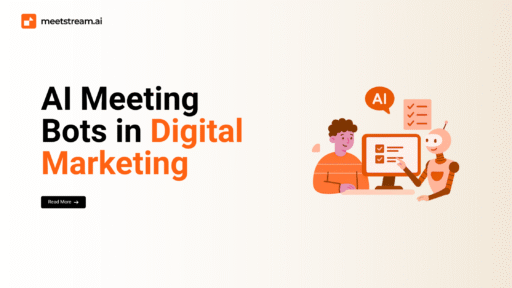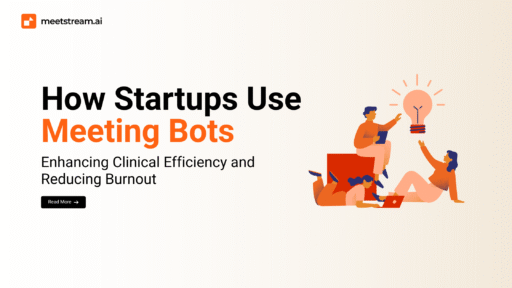Healthcare professionals—including doctors, nurses, and administrators—spend a significant portion of their time on administrative duties.
From documenting meetings to coordinating patient care across teams, these tasks, while essential, often pull clinicians away from direct patient interaction and contribute to stress and burnout.
AI meeting bots are emerging as a game-changing solution. Acting as intelligent virtual assistants, these bots join meetings, transcribe conversations in real time, summarize discussions, and generate structured clinical documentation.
This shift not only streamlines workflows but also enhances accuracy, compliance, and clinician satisfaction.
What Are AI Meeting Bots and How Do They Work in Healthcare?
AI meeting bots function as advanced digital scribes in clinical settings.
They integrate seamlessly into care teams’ routines, auto-joining internal meetings, clinical huddles, or interdisciplinary case reviews.
Whether the interaction is in-person or virtual, these bots record conversations silently, transcribe them with high fidelity, and create timestamped logs that feed directly into Electronic Health Records (EHRs).
More than just transcribers, these bots apply medical Natural Language Processing (NLP) to organize content into EHR-ready formats.
Using standards like FHIR and HL7, they populate key sections such as “Chief Complaint,” “Assessment & Plan,” and “Medications.”
During multidisciplinary team (MDT) meetings, they capture clinical decisions, attribute comments to the correct speaker, and flag action items, ensuring consistent follow-through.
Some advanced platforms even allow bots to retrieve lab results, alert clinicians about pending tasks, and provide real-time summaries, functioning as proactive partners in patient care.
Key Benefits of AI Meeting Bots in Healthcare
1. Reduced Documentation Burden:
AI meeting bots significantly lessen the time spent on note-taking and follow-up documentation.
Clinicians can spend more time with patients, reducing after-hours charting and improving work-life balance.
2. Increased Accuracy and Reduced Errors:
With medically tuned NLP engines, these bots deliver highly accurate transcriptions and clinical summaries.
Timestamped records provide traceability for billing, quality audits, and legal defense.
3. Better Care Coordination:
Structured meeting summaries and real-time action items are automatically shared across care teams, improving handoffs and communication between departments and shifts.
4. Enhanced Compliance:
Designed with HIPAA, GDPR, and other healthcare data standards in mind, these bots offer secure storage, encryption, and customizable retention policies.
5. Real-Time Clinical Insights:
Some bots detect changes in treatment plans, flag abnormal lab results, and highlight urgent tasks, enabling more responsive and informed clinical decisions.
6. Support for Quality Improvement:
Aggregate analysis of meeting transcripts reveals systemic issues, workflow inefficiencies, and care delivery gaps, supporting continuous improvement efforts.
For healthcare organizations that want these capabilities in a fully customizable way, Meetstream.ai provides the API infrastructure to build your own HIPAA-compliant meeting bots.
Its developer-ready platform allows you to embed real-time transcription, medical NLP, EHR integration, task detection, and compliance safeguards directly into your existing systems.
Instead of relying on off-the-shelf solutions, you can create bots tailored to your workflows—whether for clinical documentation, patient care coordination, or research collaboration.

Common Clinical Use Cases of AI Meeting Bots
Multidisciplinary Team Meetings: Automatically capture decisions, responsibilities, and follow-ups during oncology boards, surgical planning sessions, or case reviews.
Telehealth Visits: Record both audio and chat interactions, then generate visit summaries, prescriptions, and care instructions integrated into the EHR.
Medical Education & Training: Transcribe grand rounds, CME sessions, and seminars, turning them into searchable content for ongoing learning.
Clinical Research & Case Documentation: Index and structure complex case discussions for easy reference, audit, and publication.
Challenges and Considerations of Meeting Bots
1. Data Privacy and Security: AI meeting bots must comply with HIPAA, employ end-to-end encryption (e.g., AES-256, TLS), enforce role-based access controls, and maintain detailed audit logs.
2. Consent Management: Clear protocols must be in place to obtain verbal or written consent from patients and providers. Bots should support opt-out and data purging options.
3. Medical NLP Accuracy: Language models must be specialized in clinical terminology, abbreviations, and dialects. Continuous clinician feedback is essential to refine model outputs.
4. Seamless Integration: Bots must support EHR APIs (FHIR/HL7) and interface smoothly with scheduling systems, calendars, and patient portals for full workflow compatibility.
Choosing the Right AI Meeting Bot for Healthcare
Healthcare organizations should seek platforms purpose-built for clinical settings. MeetStream.ai is a strong example:
- HIPAA-Compliant: Secure by design with encryption, access controls, and consent management.
- Medical NLP Engine: Tailored for complex medical terminology, enhancing transcription quality.
- EHR Integration: Compatible with Epic, Cerner, and other major systems via HL7/FHIR.
- Advanced Features: Real-time action detection, multilingual support, speaker diarization, CDS integration, and CRM support.
MeetStream empowers hospitals, clinics, and research teams to automate documentation, improve clinical alignment, and maintain regulatory compliance with ease.
The Future of AI Meeting Automation in Healthcare
As generative AI and predictive analytics evolve, future AI bots will:
- Identify care gaps and flag readmission risks.
- Draft discharge summaries, referrals, and care plans.
- Deliver personalized summaries based on provider preferences.
- Offer embedded clinical decision support in real time.
These innovations will further reduce administrative overhead, enhance patient care, and support faster, more accurate medical decisions.
Final Thoughts
In today’s healthcare environment, reducing administrative burden while improving care quality is non-negotiable.
AI meeting bots are helping achieve this balance by turning clinical conversations into accurate, actionable, and compliant records.
With Meetstream.ai, healthcare teams can take this a step further—building secure, medically intelligent meeting bots designed for their unique workflows.
The result is more time for patient care, stronger collaboration, and a scalable approach to meeting documentation in the digital age.
FAQs About AI Meeting Bots in Healthcare
Are AI meeting bots legal in medical settings?
Yes, provided they comply with HIPAA, secure data handling, and informed consent policies.
Can bots update patient EHRs automatically?
Yes. Bots integrated with FHIR or HL7 APIs can insert structured notes directly into EHRs.
How secure are these bots for sensitive data?
High-end platforms use encryption, RBAC, audit logs, and secure storage to protect data.
Can a patient opt out of being recorded?
Absolutely. Bots must allow real-time opt-out and deletion of recorded data upon request.
Do AI bots support group clinical meetings?
Yes. With speaker diarization and NLP tagging, bots can handle complex, multi-participant discussions such as MDTs or interdisciplinary case reviews.

